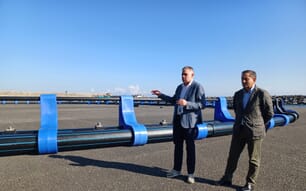Thanks to its rapid growth and high economic value, eastern little tuna (Euthynnus affinis) has been drawing much attention in Japan as a novel aquaculture species. Hitting supermarket shelves for the first time this year, it's known as suma in Japanese and is a member of the mackerel family renowned for its fatty meat.
According to the FAO (Food and Agricultural Organization of the United Nations), suma is of high economic value in tropical and subtropical areas and demand for the species has gone up considerably over the past 5 decades. As a result, the global capture production of suma rose to around 300,000 tonnes in 2011.
Wakayama Prefecture in Japan's Kii Peninsula began artificially breeding the fish in 2012. The first 50 or so born in the summer of 2014 were harvested on January 15th, in a cultivation preserve off Kushimoto in the southern part of Wakayama Prefecture. Other universities and organisations are now following suit.
Today, wild-caught juveniles are currently used as seed for suma farming but large-scale fishing of suma in waters around Japan is impossible, as the fish don't form shoals that are large enough.
Suma seeds are usually obtained as bycatch from fishing operations that target juvenile Pacific bluefin tuna for use as seed in tuna farming.
One reason why suma has potential in aquaculture is its size. Its commercial size is around 1.5kg in weight and 45cm in length, which means that it can be reared in small net pen facilities that are also used for some of Japan's conventional aquaculture species like red sea bream (Pagrus major) and yellowtail (Seriola quinqueradiata).
Small family-owned businesses that tend to make up the majority of Japan's fish farming operations run such facilities, so suma could serve as a substitute for conventional species that are reared in Japan.
Despite the potential of suma, there are still some difficulties to overcome. For example, keeping the fish alive through winter is particularly challenging. Suma are usually found in waters with a temperature range of between 18°C and 28°C but the low water temperatures observed around Japan in the winter make it difficult to maintain suma seed. It is therefore crucial that suma are reared in temperatures that are higher than natural seawater in order to achieve full-cycle aquaculture.
Suma also mature and spawn in waters ranging from 24-28°C, which means that maintaining suitable water temperatures in tanks to allow for stable maturation is important.
Another difficulty lies with the flesh of suma, which rots quickly if not appropriately treated. Even if the fish are in good condition when harvested, treatment such as paralysing or bleeding fish subsequent to harvest and immediately icing in chilled seawater are required to prevent rotting. This means that the marketability of suma in the sashimi or sushi markets is limited to local catch and consumption. Aquaculture could therefore be one way to address this problem, as it allows for quicker processing and preservation compared to what can be done on fishing vessels.
Studies carried out by Tokyo University of Marine Science and Technology have shown that suma reared at high temperatures in land-based tanks and fed to satiation successfully reproduced at 1 years old and 40cm in length.
With respect to aquaculture, this presents a great advantage as it allows the selective breeding of suma to be achieved within a relatively short time period using little space. Broodstock maintenance involving suma not only allows for cost and space reductions, but it also allows precise breeding programmes to be implemented, such as breeding only with selected families. This kind of breeding improves commercially important traits for aquaculture production, such as survival, growth rate and tolerance for rearing in small areas. However, survival rates during early developmental stages can still be low due to aggressive behaviour and cannibalism resulting from the piscivorous behaviour of suma leading to high mortality rates.
There were also reports of collisions with the tank that led to mortalities and physical abnormalities such as a decline in swimming performance but lighting tanks for 24 hours or maintaining the water currents have effectively reduced the number of collisions between fish and the tank walls.
Meanwhile, a fish market in Wakayama Prefecture, Hankyu department store in Osaka and Mitsukoshi department store in Tokyo were among the first to receive this year's first shipment of suma. Wakayama Prefecture's goal now is to reduce artificial cultivation costs and improve methods of mass production in the hope that suma will one day become a specialty of the prefecture.


